Well thank you for the compliment. Most kind of you.
I think they look better than they sound.... they're good, and will be better with new tweeters, but they're not great.
Maybe a question of finding the right tweeter for an MTTM?
Try a couple of these surprising cheapies on the right 3rd or 4th order filter:
HT-22/8
Or 2X SEAS metal dome with the essential 7.5R/0.82uf Zobel, or 2X Vifa XT25 ring radiator. Thing is, IMO, a lot of tweeters sound rubbish. Especially soft domes, but maybe ribbons too.
Last edited:
It's easy to get decent sound from a dome, but I find that properly implemented a ribbon provides transient resolution (low settling time) that domes can't match. I'm spoiled; next to a plasma tweeter, the 60-inch ribbons in my Magneplanar MG 3.6's are the best tweeters I've ever heard.
Ribbons (and AMTs too) have their issues, and can be hard to work with. In general, ribbon THD isn't great in the lower part of their range, although there are some ribbons that are much better than others in this regard, in particular the RAAL ribbon. However RALL ribbons are very costly. Rick at Selah says the ribbon he's using in the Anniversario has respectably low THD down to 1800 Hz. I've ordered one, we shall see.
The problem I had with that 3 way was that Fountek ribbon wouldn't go low enough to properly cross to the SEAS drivers. The SEAS drivers have bad metal-cone breakup issues that start around 3 kHz and you really want to cross over no higher than about 2.5 kHz and preferably below 2 kHz if you can, with very steep slopes, and this can't work with that Fountek tweeter.
There is also some problem I faced getting the speaker to sound "warm" enough in the upper bass (150~250 Hz or so) without sounding "chesty." But then, when I was playing with these 3-ways I had no measuring mic or measuring software, everything was by ear and to some degree manually with a sine generator and an SPL meter. Nowadays I have measuring software, so likely I could voice these speakers properly now.
Ribbons (and AMTs too) have their issues, and can be hard to work with. In general, ribbon THD isn't great in the lower part of their range, although there are some ribbons that are much better than others in this regard, in particular the RAAL ribbon. However RALL ribbons are very costly. Rick at Selah says the ribbon he's using in the Anniversario has respectably low THD down to 1800 Hz. I've ordered one, we shall see.
The problem I had with that 3 way was that Fountek ribbon wouldn't go low enough to properly cross to the SEAS drivers. The SEAS drivers have bad metal-cone breakup issues that start around 3 kHz and you really want to cross over no higher than about 2.5 kHz and preferably below 2 kHz if you can, with very steep slopes, and this can't work with that Fountek tweeter.
There is also some problem I faced getting the speaker to sound "warm" enough in the upper bass (150~250 Hz or so) without sounding "chesty." But then, when I was playing with these 3-ways I had no measuring mic or measuring software, everything was by ear and to some degree manually with a sine generator and an SPL meter. Nowadays I have measuring software, so likely I could voice these speakers properly now.
now THAT is pretty. Love deep speakers.Not applicable to nearfield use.
Here's another speaker I built, designed for normal room type listening rather than nearfield use:
An externally hosted image should be here but it was not working when we last tested it.
Unfortunately, the vertical dispersion on a ribbon tweeter is near zero.
Regards,
Dan
Which is great for reducing those troublesome ceiling reflections.... (imo a good thing)
If crossed too high or c-c distance is too high, it can harm integration with the midbass driver.
Done right (i.e. Not necessarily an MTM) a good ribbon can sound eerily natural.
(I'm not the fan of domes that i once was, and neither so much of a fan of cone tweeters, even though they can both be awesome. Having narrowing dispersion in both axes and both drivers, can be rather revealing of multiple breakups)
How dumb is it to use a tweeter with a vertically aligned radiation pattern with a standard woofer?
This tweeter is best used in an MTM. Seemples. Then the radiation of the woofers and tweeter falls off similarly with distance. You guys are so dumb. Sorry.
You may be much more intelligent than all the rest of us, but you are plain wrong on this one.
The simple fact of the matter is that at the xover frequency, the woofer has much larger dimensions than the whatever kind of tweeter you use. In other words, the dispersion pattern of the woofer will be considerably narrower than that of the tweeter, regardless of the kind of tweeter being used. Just to make it absolutely clear, at xover, both ribbons and domes will have a virtually identical dispersion pattern. If something is beaming, it will be the woofer.
In other words, you got this part of the theory wrong. In addition, you overlook the major reason why a ribbon in an mtm configuration usually isn't the best option: driver distance. With a mtm, it is important to keep the two m's as close together as practical. This works best with a dome tweeter like those produced by Vifa, Seas and others. By using a neodymium motor, these tweeters are barely larger than their dome surround.
Last edited:
The Fountek ribbons can't cross over low enough to work with the Satori woofers; really the crossover wants to be 1800 Hz or even 1500, otherwise the Satori driver adds a fairly colored low treble to the sound. So I am trying two other tweeters- the AMTPRO-4 from Dayton, and a new ribbon from Selah Audio that works down to 1800 Hz.
Experimenting now with the Dayton AMTPRO-4 tweeter. Here's how REW sees the AMTPRO-4 frequency response when the back of the tweeter is closed off by a flat plate (the AMTPRO-4 comes with a felt pad at it's back, that felt pad was retained in this measurement, but the tweeter itself is placed on a flat steel plate and sticks there by dint of the strong magnets in the back.)
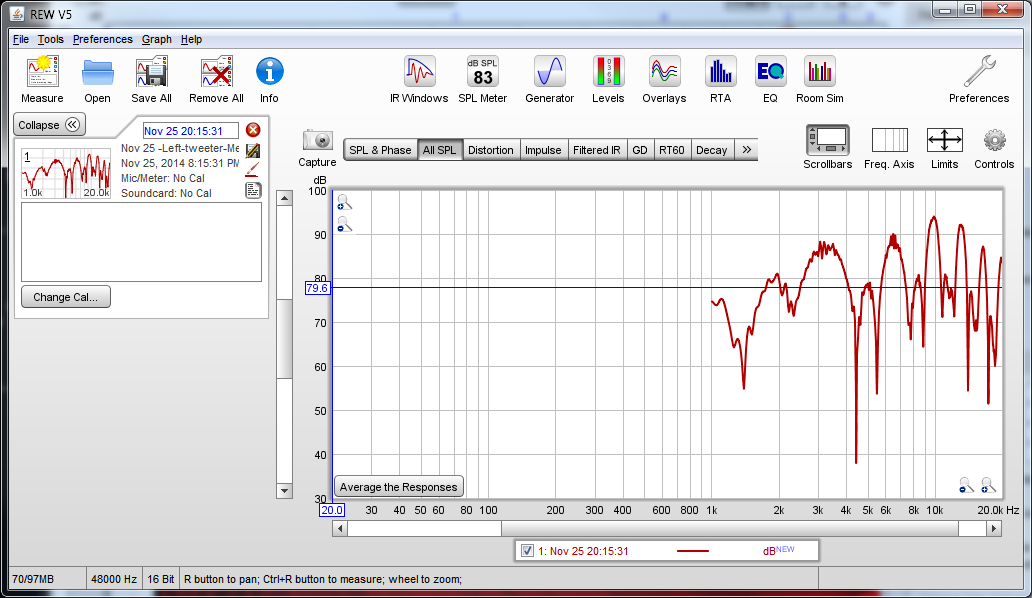
Here's how REW saw the frequency response when I hung the tweeter in the middle of a large room so I was measuring the on-axis response "in free air."
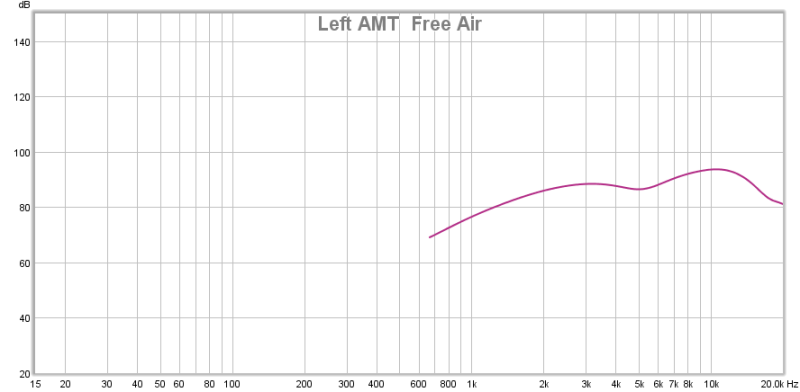
So I think one needs to avoid the back wave from reflecting off any nearby surface behind it - this seem to cause a kind of comb-filter of reinforcement and cancellation.
I am going to try to build a chamber for the AMTPRO-4 that will absorb as much of the back wave as practical, something like this-
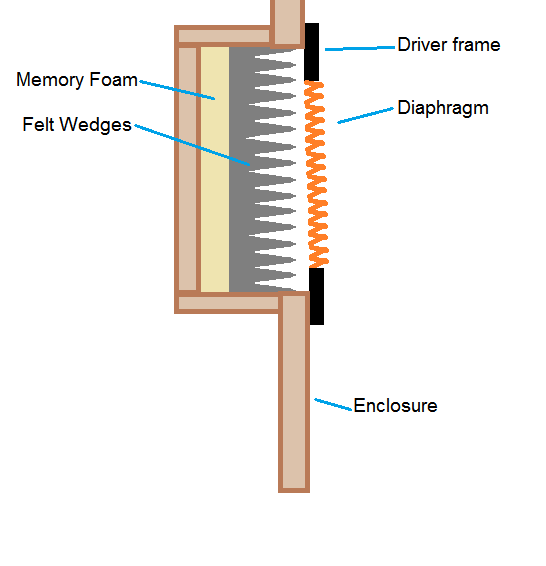
I think ideally it would work best in a long, terminated tapered transmission line- like the "nautilus" design that B&W uses for tweeters (and midranges in some fancy designs.) But I don't know if that's practical in my speaker, so I am just going to try to make the chamber be the best absorber of treble I can come up with. To that end I've bough a bunch of 1/2 inch thick grade F13 felt and a slab of 20 durometer viscoelsastic foam with which to line my chamber, and I've developed a way to make a stack of wedges from the felt.
Experimenting now with the Dayton AMTPRO-4 tweeter. Here's how REW sees the AMTPRO-4 frequency response when the back of the tweeter is closed off by a flat plate (the AMTPRO-4 comes with a felt pad at it's back, that felt pad was retained in this measurement, but the tweeter itself is placed on a flat steel plate and sticks there by dint of the strong magnets in the back.)

Here's how REW saw the frequency response when I hung the tweeter in the middle of a large room so I was measuring the on-axis response "in free air."

So I think one needs to avoid the back wave from reflecting off any nearby surface behind it - this seem to cause a kind of comb-filter of reinforcement and cancellation.
I am going to try to build a chamber for the AMTPRO-4 that will absorb as much of the back wave as practical, something like this-

I think ideally it would work best in a long, terminated tapered transmission line- like the "nautilus" design that B&W uses for tweeters (and midranges in some fancy designs.) But I don't know if that's practical in my speaker, so I am just going to try to make the chamber be the best absorber of treble I can come up with. To that end I've bough a bunch of 1/2 inch thick grade F13 felt and a slab of 20 durometer viscoelsastic foam with which to line my chamber, and I've developed a way to make a stack of wedges from the felt.
I like the way you are proposing your absorptive enclosure, but, I would do it differently. I'd make the sides a bit deeper and NOT use a back panel at all.
Of course, this is just my opinion.
You have to use a back panel - otherwise the pressure from woofer excursions will screw up the AMT diaphragm. You have the seal the AMT off from the woofer.
If you used a duct instead of a chamber, running all the way through the speaker enclosure to an opening on the back of the cabinet, that would be best. You could even taper it a bit, with 'progressive stuffing density' and it would be a classic transmission line operating in the midrange. Unlike a cone speaker, the output from the back of the diaphragm is actually IN PHASE with the sound from the front of the AMT, so perhaps you'd have to rethink the physics here a little- although with the shorter wavelengths at midrange frequencies maybe this is moot; at 800 Hz the wavelength is 17 inches - which I think is the very lowest you could use this driver even with a tuned transmission line helping out it's low frequency performance- so perhaps the issue of phasing the backwave properly in relation to the front just just doesn't matter, as it would with longer-wavelength bass.
In my case, due to reinforcing framework inside the enclosure, and the fact that the reflex port is back there behind the tweeter- I can't use a duct.
Crossing over the AMT around 1500 Hz give a nice result on first listen, so I think this is going in the right direction.
While the Fountek's need for a 3kHz or higher crossover didn't work with the Satori driver, it's high sensitivity worked just fine in terms of my bi-amp amp's power. However the AMT needs more power than the little 0.75 ~ 1.0 watt tube amp can produce. So now I am building a little solid state class A amp, which will be a while in building.
Also, the MiniDSP 2x4 doesn't have quite enough output to drive the treble amp I'm making- it only has 0.9 volts output max - so I've got a MiniDSP BALANCED 2x4 coming, which has 2 volts out unbalanced which will be better.... the regular MiniDSP has 0.9 volts out but if you use the digital volume control via pot options, it's only 0.61 volts, not enough.
Catalog engineering, hahaha. I could build a little opamp buffer, I suppose, but I'll try the higher-output MiniDSP module instead.
While the Fountek's need for a 3kHz or higher crossover didn't work with the Satori driver, it's high sensitivity worked just fine in terms of my bi-amp amp's power. However the AMT needs more power than the little 0.75 ~ 1.0 watt tube amp can produce. So now I am building a little solid state class A amp, which will be a while in building.
Also, the MiniDSP 2x4 doesn't have quite enough output to drive the treble amp I'm making- it only has 0.9 volts output max - so I've got a MiniDSP BALANCED 2x4 coming, which has 2 volts out unbalanced which will be better.... the regular MiniDSP has 0.9 volts out but if you use the digital volume control via pot options, it's only 0.61 volts, not enough.
Catalog engineering, hahaha. I could build a little opamp buffer, I suppose, but I'll try the higher-output MiniDSP module instead.
Reading your posts with interest as I was also looking for suitable ribbon type tweet to match the Satori. Slightly worried that you say the Satori needs to be crossed so low (colouration issue)- I was hoping I could get away with 2.3khz
The tweets I looked at were the Fountek X2.0/X3.0, Beyma, AC AST2560 and Eton ER4
IMO the last two look the most promising; the Eton can be crossed very low but its pricey
https://www.intertechnik.com/Shop/Loudspeakers/Eton/_ER4_1768,en,855,47326
The tweets I looked at were the Fountek X2.0/X3.0, Beyma, AC AST2560 and Eton ER4
IMO the last two look the most promising; the Eton can be crossed very low but its pricey
https://www.intertechnik.com/Shop/Loudspeakers/Eton/_ER4_1768,en,855,47326
I would not personally accept the statement that the satori is colored. In reality, its distortion is probably better than the tweeters it is crossing to. Much more likely hat you are hearing a combo that simply does not work well together or a tweeter that is not meant to go so low and is straining. It could be argued that the Satori is one of the best drivers available in its class, if not the best. It doesn't cost a lot, but performs as well as anything else out there.
Never heard that before either, I hope its not a big issue because I wanted to use with the AC aero striction tweets at a safe x/o point
Not worried about beaming issues, personally think too much is fuss is made over this. The satoris beam but still only 3dB down @ 3khz /30 degrees
Not worried about beaming issues, personally think too much is fuss is made over this. The satoris beam but still only 3dB down @ 3khz /30 degrees
Last edited:
Bill, if you happen to be designing a 3-way there are new 5" Satori drivers coming out soon. Solen Electronique Inc.
Maybe you want to look at this tweeter too. Apparently, it will go a little lower than some other ribbons.
Creative Sound - Product Details
Maybe you want to look at this tweeter too. Apparently, it will go a little lower than some other ribbons.
Creative Sound - Product Details
Bill, if you happen to be designing a 3-way there are new 5" Satori drivers coming out soon. Solen Electronique Inc.
Maybe you want to look at this tweeter too. Apparently, it will go a little lower than some other ribbons.
Creative Sound - Product Details
Thanks !
Aware of the smaller satori - also I've got two pairs of the 6.5" and need to do something with them quickly
Because of the lovely looking chassis, I'd love to do an isobaric design with 7.5" satori, when it comes out
Last edited:
I would not personally accept the statement that the satori is colored. In reality, its distortion is probably better than the tweeters it is crossing to. Much more likely hat you are hearing a combo that simply does not work well together or a tweeter that is not meant to go so low and is straining. It could be argued that the Satori is one of the best drivers available in its class, if not the best. It doesn't cost a lot, but performs as well as anything else out there.
Have you built any designs with the Satori?
My initial idea was to cross the Satori to the Fountek 5inch ribbon at 3 kHz. This didn't sound good at all. THD measurements were OK but the sound wasn't good. Seemed to me like a time domain issue- maybe too much stored energy in the Satori cone above 2 kHz.
Moving the crossover down to 2.5 and then 2.3 kHz gave a good improvement from the Satori, but the Fountek showed signs of not liking that. So I tried the Dayton AMTPRO-4 which worked well at 2.3 kHz, and I also tried it at 1.5 kHz, and it was fine there too. Using the Satori up to 2.3 kHz is OK, but the AMT has better detail and cleaner sounding transients - and also seems a bit more "dynamic"- and it sounded better to me to cross over at 1.5 kHz than 2.3.
Selah Audio is selling the ribbon driver they use in their Anniversario, I have a pair, and they are excellent sounding. I've found I can use them down to 1.8 kHz very well with a 48 dB/octave crossover. (This 2-way project is biamped using MiniDSP harware.)
Even though I like the Selah ribbon better in some ways than the AMT, I have another speaker where I want to use that Selah ribbon and I think I am going to use the AMT here. (Either of the AMT or Selah ribbon drivers will fit in this design, but the other speaker only the Selah ribbon will fit.)
But here's a major problem I face- I don't have enough room to use all the speakers I build!!!!
Built two versions of Jeff Bagby's kairos. I would suggest reading that speakers write up as well as looking at the SB Acoustics Moniter thread here. In it Joachim Gerhard uses the 4 ohm version. Maybe you are right, but there is nothing in any of the measurements I have seen that would correspond with what you have found. It's a really clean driver with the exception of the cone edge resonance and that is happening below your problem area.
I am used to listening to my Quad ESL-57's, and a DEQX / triamp pair of Magnepan MG 3.6's, and Stax electrostatic headphones too.... plus I have a bit of hyperacousis, such that certain mid/treble frequencies are exaggerated... so maybe there's something that stands out to me as colored that most folks would judge in a more balanced perspective. But here's the Satori's waterfall from Zaph's tests, and I think it shows what I am hearing:
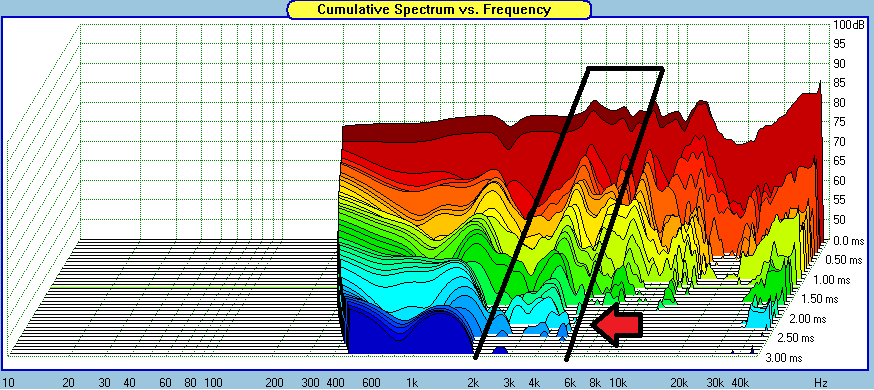
Even though this is actually better than most 6.5" drivers in terms of delayed release of stored energy, compare it to the performance of a typical ribbon (here, an Aurum Cantus APR 1.2 , which the mfg. says can be used down to 2300 Hz)
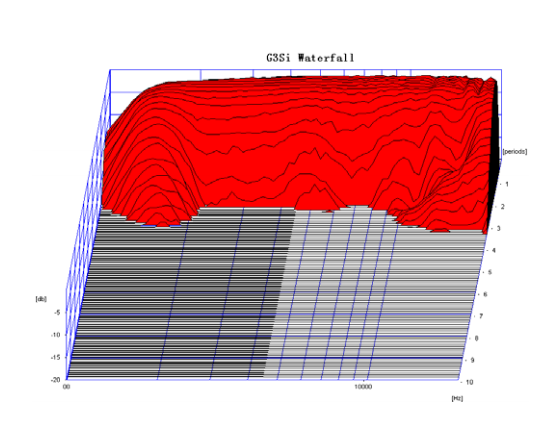
This isn't a perfect apples-to-apples comparison as these plots are not quite comparable in terms of scale and other details of construction, but I think it does show that there is something measurable here that might correspond to what I am hearing.

Even though this is actually better than most 6.5" drivers in terms of delayed release of stored energy, compare it to the performance of a typical ribbon (here, an Aurum Cantus APR 1.2 , which the mfg. says can be used down to 2300 Hz)

This isn't a perfect apples-to-apples comparison as these plots are not quite comparable in terms of scale and other details of construction, but I think it does show that there is something measurable here that might correspond to what I am hearing.
- Status
- This old topic is closed. If you want to reopen this topic, contact a moderator using the "Report Post" button.
- Home
- Loudspeakers
- Multi-Way
- Anyone using Fountek NeoCD 2.0 5" ribbons?